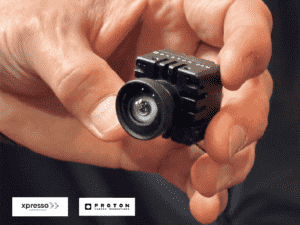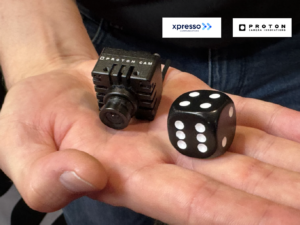How PR Can Support the International Launch of a Technology Startup
PROTON Debuted the World’s Smallest Camera at NAB 2024
In a society of information overload, where we are bombarded with sales messages, adverts, information and news every day, it is easy to become sceptical about the value of a ‘conventional’ communications strategy for your business. And certainly, at Xpresso we have always been keen to promote the benefits inherent in a joined-up strategy that leverages the opportunities of a more creative and dynamic approach to audience engagement.
But as with so many things, a fundamental grasp of the basics must always sit at the heart of that strategy. And nothing is more fundamental to communications than a good Press Release.
This blog outlines how Xpresso’s new start-up client – Proton – achieved incredible initial market penetration, simply through a well-written, well-timed and well-placed PR, resulting in:
- Extensive coverage in 90% of global Trade Publications
- A number of requests for follow-up interviews from key industry publications, including an NAB video interview
- Significant footfall to their booth
- Over 100 units sold at the show, with many further follow-up sales appointments made
What is PR?
PR (Press Relations/Public Relations) refers to the act of engaging with the press, and in the name of an entire industry as well. But ‘PR’ is also used as a noun (a ‘Press Release’) – a specific document that allows companies to deliver new announcements to the media. Most often, this will be a new product, but it can be a whole range of other information; mergers, acquisitions, collaborations, C-suite changes, event attendance, charitable actions… The list goes on. The key thing is that it is a tangible, novel piece of news which will be of interest to industry media.
Proton: a masterclass in the value of a well-written PR
 A while ago, a start-up company in the field of miniaturised cameras – Proton – reached out to Xpresso Communications to ask for help with their communications strategy. Their central objective was to launch their new camera – the smallest broadcast camera on the market – and in particular to use the industry’s largest tradeshow, NAB, as a platform to generate interest and make initial sales.
A while ago, a start-up company in the field of miniaturised cameras – Proton – reached out to Xpresso Communications to ask for help with their communications strategy. Their central objective was to launch their new camera – the smallest broadcast camera on the market – and in particular to use the industry’s largest tradeshow, NAB, as a platform to generate interest and make initial sales.
The first key step was to have a virtual meeting to establish all of the key aspects of the business; positioning, strategy, goals and – most important of all – the product details and the end-user benefit they are designed to deliver.
Because Xpresso has an extensive technology background and a well-developed knowledge base within the broadcast industry, the process was remarkably straightforward. Marko Hoepken, CEO for PROTON described it thus:
“There can be a real worry in onboarding an external agency, because you worry how much time it will take to walk them through your business and product. But because Xpresso already understand the industry, its products, technologies, challenges, competitors and strategies, then it’s more like having a meeting with a member of your own team. Getting them up to speed took no time at all”.
From here, it was Xpresso’s job to take the product information and details of show attendance, and craft it into a compelling, well-written and informative Press Release. We then leveraged our extensive distribution lists – established over decades of personal connection with key players in the broadcast and journalism industries – in order to make sure the content achieved global reach and was seen by the decision-makers that matter.
Crafting the Perfect PR
There are a couple of key dimensions that set PR writing apart from other styles of writing – and these can often trip up firms who are seeking to issue PRs on their own. An intrinsic understanding of the form, purpose and conventions of PR writing was key to Xpresso’s and Proton’s success in capturing the interest of journalists across the world:
- Despite being issued by the company to promote their product, PR writing should not be a piece of sales writing. Overblown adjectives and hyperbole will guarantee a Press Release is passed over. The writing needs to deliver (close-to) objective product detail and meaningful explanation of the benefits delivered, nothing more.\
- PRs need to be delivered in a way that makes the lives of journalists easier. This means copy that reads well and is targeted to a specific audience, and which can be directly cut & pasted into an article, if needed. It also needs to be ‘safe’ content; meaning it has been verified and signed-off by the company and any other company it references, so that journalists don’t need to chase down sources for verification.
- Visuals need to be relevant, high-res and free to be published.
- Timing is everything. Journalists work to tight deadlines and event-based announcements are often assembled weeks before the event itself. Content which is delivered not just on time but ahead of time is always valued.
Xpresso Communications were able to achieve such successful results on behalf of Proton in part because of their already established relationship with the industry. Journalists know when an Xpresso PR passes their desk that it will contain the information they need, in an easy-to-access format, validated, on-time and ready-to-go.
their already established relationship with the industry. Journalists know when an Xpresso PR passes their desk that it will contain the information they need, in an easy-to-access format, validated, on-time and ready-to-go.
Tying PR into the bigger picture
PRs are fundamental to a good communications strategy, but they are only one piece of the puzzle. Press coverage through a well-written PR works brilliantly in terms of visibility – especially before something like a tradeshow, since it drives attendance to the booth. But to sustain that initial energy, a PR needs to be combined with a holistic, integrated and strategic communications plan – because PRs alone have a relatively short lifespan. Adding in a series of social media posts, blogs and case-studies derived from that initial PR extends the duration and depth of market impact.
Advertising is also a valuable tool, but generally only achieves its full value after a strong initial communications strategy has been set in place. Many start-ups will be ready to think about advertising after about six months, so long as they have set effective groundwork with their initial comms strategy.
The results
The results listed at the beginning of this blog – in terms of journalist outreach, booth attendance and units sold – demonstrate the tangible results of an effective PR. Proton CEO Marko Hoepken and his team placed their trust in Xpresso because they knew that our extensive reach and reputation would ensure that their launch PR would be seen, acknowledged and acted upon by the stakeholders that matter.
Speaking of the success of their product launch, their attendance at NAB and the role the press release had, Marko Hoepken said:
“We have known Fiorenza for many years, having crossed paths with her at industry events frequently. Xpresso’s reputation in the field is well established, and our trust in them was well placed; we couldn’t be happier with how the launch of the Proton camera has gone. They understood immediately our value-proposition and did an impressive job of communicating this to the market. We look forward to continuing our work with Xpresso to build on this launch success, and develop an integrated comms strategy which maintains and builds upon Proton’s visibility in the field”.






